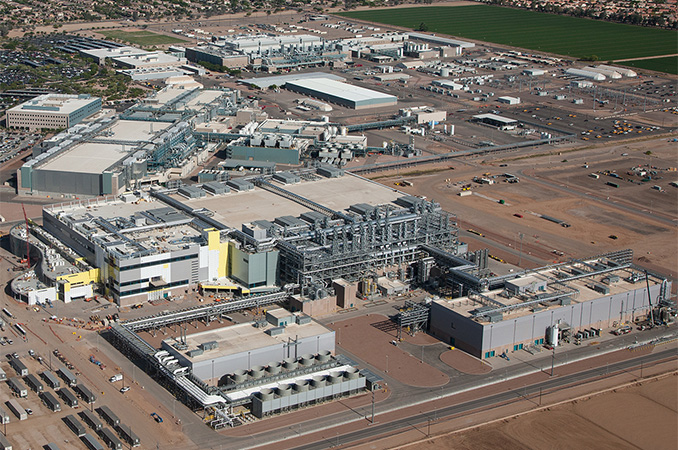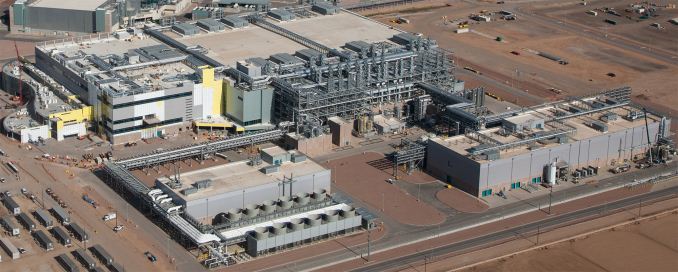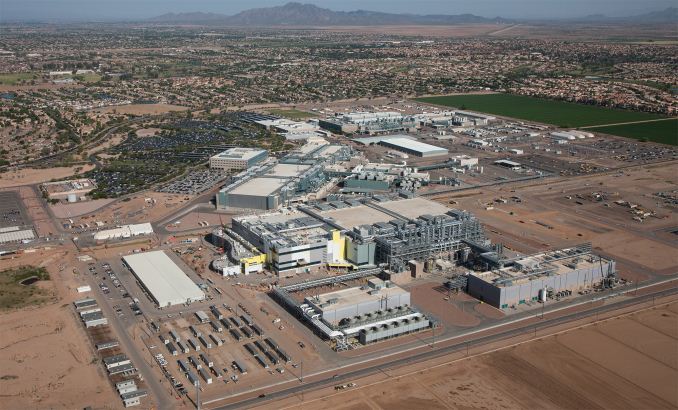Intel to Equip Fab 42 for 7 nm
by Anton Shilov on February 9, 2017 4:45 PM EST
Intel this week announced plans to bring its Fab 42 online to produce semiconductors using a 7 nm fabrication process. It will take three to four years, and the move will cost Intel several billions of dollars but will create approximately 3,000 of high-tech jobs in Chandler, Arizona. Unfortunately, Intel did not share details about its 7 nm manufacturing technology at this time.
Intel began construction of its Fab 42 back in 2011 with the aim to build the most advanced, high-volume chip production facility in the world. The building was completed in 2013, but instead of moving in equipment to produce chips using 14 nm fabrication process, Intel decided to postpone its completion in early 2014. The site is equipped with heating, air conditioning, and other essential things, but no actual semiconductor manufacturing equipment has been installed. Intel still has no immediate public plans to use the Fab 42 for the production of chips using its 10 nm process technology in the short-term future but has indicated it intends to use it for its 7 nm ICs several years down the road.
Intel intends to spend as much as $7 billion to equip Fab 42, but at the moment the company does not share what kind of tools it plans to install. As a result we have no new information about Intel's 7 nm technology. Intel has implied that it could start using extreme ultraviolet (EUV) lithography at 7 nm, but has never committed to the plan. Earlier this year the company said it would invest in a 7 nm pilot line in one of its development sites, but did not elaborate beyond that. One of the things that the CEO of Intel disclosed about the 7 nm in general in his email to employees this week is that it requires “an increasing amount of factory space per wafer.” This possibly means that Intel will insert EUV equipment into the process technology for cirical layers and will continue to use a lot of multipatterning, which increases the diversity requirements for the production tools.
Intel believes that when completed, Fab 42 will be the most advanced semiconductor wafer fab in the world that will create 3,000 direct high-tech jobs and 10,000 direct and indirect jobs in total. It should be noted that the semiconductor company will not start to move in equipment into the Fab 42 before it figures out all the peculiarities of the 7 nm manufacturing technology. Once it finalizes the pilot line and is satisfied with the equipment performance, it starts to replicate the line at different sites.
Intel said that it will use its 7 nm fabrication process to produce various processors for PCs, data centers and other devices that will be used for AI, automated driving, medical research/treatment as well as other applications. So, as usually, the manufacturing technology will be positioned to make the whole stack of Intel’s products several years from now.
Related Reading:
Source: Intel












24 Comments
View All Comments
HStewart - Thursday, December 6, 2018 - link
I would say that people are not replacing computers for cell phones - but cell phone are addition and in some cases people don't need a computer and just use cell phoneSony and Samsung are both bad examples of this, I don't believe either company has ever made a desktop computer Samsung has be mostly android - but starting with Samsung TabPro S, Samsung has made a windows based tablet.
Apple is the weird case, not going touch on Mac lines, and pretty much desktop is gone unless you consider mini and all in one desktops
Intel is not going to give up - technology will change - with recent changes in Intel personal and FABs, I think it is Intel haters dream that Intel will give up production.
Only thing stated here possibly right, is doomsday of desktop computers but It likely less than 10 years - as soon as mobile processors are as fast as desktop and can cheaply get external GPU's if required for mobile, desktop is gone. For majority of uses it is already, just go into local BestBuy and count Desktop vs Laptop or even include ARM Tablets
HStewart - Thursday, December 6, 2018 - link
But it does cost to make smaller technology, but that is for every company not just IntelHStewart - Thursday, December 6, 2018 - link
I actually pay double for same level of technology for time period 10 or so year ago.Cost will actually go down.
Example Dell Inspiron 7000 with 300Mhz Pentium 300 cost $3500. My dell XPS 13 2in1 runs circle around it and cost $1100. Ten years ago my Supermicro Dual Xeon 5160 cost me $8000 but until i5/i7 series came out nothing could touch it. Now the same XPS 13 2in1 above can out performed with i7 Y cpu.
SkyBill40 - Monday, March 13, 2017 - link
I live right up the road from the plant and it's quite the footprint. It'll be interesting to see what the future holds for Chandler as well as Intel. Given how AMD has had a resurgence of sorts with the Ryzen launch, Intel is going to need something greater than the refresh it's milked out of the last few series. Will that come on the 7nm fab? I suppose we'll see.